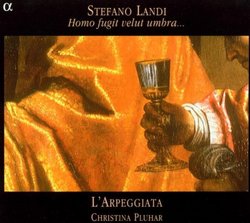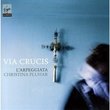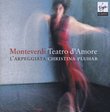| All Artists: L'Arpeggiata/Pluhar, Christi Title: Stefano Landi: Homo fugi velut umbra... Members Wishing: 1 Total Copies: 0 Label: ALPHA PRODUCTIONS Release Date: 1/1/2002 Genres: Dance & Electronic, Pop, Classical Styles: Vocal Pop, Chamber Music, Historical Periods, Baroque (c.1600-1750) Number of Discs: 1 SwapaCD Credits: 1 |
Search - L'Arpeggiata/Pluhar, Christi :: Stefano Landi: Homo fugi velut umbra...
 | L'Arpeggiata/Pluhar, Christi Stefano Landi: Homo fugi velut umbra... Genres: Dance & Electronic, Pop, Classical
|
Larger Image |
CD DetailsSimilar CDs
|
CD Reviews"Hot Licks" circa 1600 Giordano Bruno | Wherever I am, I am. | 11/30/2009 (5 out of 5 stars) "Everybody involved in the 'historically informed' performance world, AKA 'Early Music', has always recognized that improvisation was a significant part of musicality in the 16th and early 17th Centuries, but there has been a lot of proper hesitation in making any claims about "knowing how such music sounded authentically." And in fact, how certain can 'we' be that we have any idea how late Renaissance and early Baroque music sounded? Okay, okay, there will always be uncertainties and differing opinions, but there are some useful sources of insight. First and foremost, the notation! Musical notation conveys a lot of information; the notation formats of the late Renaissance conveyed different sorts of info from modern notation, and since scholarly modern transcriptions inevitably convey inappropriate info, "we" have needed to read and to perform from the originals to glean ideas of performance. The rather rapid changes in notation formats from, say, 1550 to 1650 convey a huge amount of info. Second, there are the surviving instruments and the better-made replicas of them; information about tuning and about musical possibilities are built into them. There are treatises and actual detailed instructional manuals for the playing of various instruments, with pages and pages of examples of cadence decorations and 'divisions', quasi-improvisational tricks-of-the-trade known well to the professionals of the era. Also there are literary impressions and descriptions of musical performance. Finally, there is the legacy of performance styles in the 'traditional' popular music of Italy, Spain, and the once-Spanish colonies of the Caribbean: the Neapolitan and Sicilian song repertoire of the young Claudio Villa; the flamenco and Galician folk music; the shawm bands of Castile and Catalonia; the harp and 'guitar' styles of Venezuela and Cuba.
None of these sources would be quite enough, nevertheless, to assure a performer of precisely how far to go, and in what direction, with melodic and rhythmic improvisation. Not unless the performer is so thoroughly saturated in the musical idiom, that is, that such assurance comes freely. Christina Pluhar and the musicians of L'Arpeggiata have achieved such assurance. Their improvisatory treatment of the music of Stefano Landi on this CD expresses that assurance. I can't help but believe what I hear; I'm totally persuaded by the quality of the musicianship. If I can't declare with academic certitude that "this is what Landi had in mind", I CAN declare that it is amazingly plausible and worthy of its sources. Stefano Landi (1586-1639) was a Roman by birth and early training. He would have grown up in the musical culture of Southern Italy, somewhat isolated from the Franco-Flemish polyphony of the late Renaissance that dominated most of Europe. Landi went north, however, to Padua and Venice, where he acquired all the forms of the Second Practice associated with Monteverdi, the forms of monody and of composition with basso continuo. Interestingly, Monteverdi himself had probably turned to southern Italy for inspiration in his ritornellos and "stubborn" (ostinato) basses. Crossed paths of development, huh? Landi is best known now for his superb 'sacred' opera L'Alessio, the tale of the Saint who hid under the stairs, the first known opera to thoroughly synthesize monody and polyphony. L'Alessio has been superbly performed and recorded on a DVD. The 14 compositions on this CD from L'Argeggiata represent a radically different Landi, the Roman and Southern popularist with a bent for the improvisatory styles of the previous century. I'd be surprised if "you' aren't surprised by the exuberance of this music, and by how 'folksy' it sounds. Andalusian! Caribbean! There are tarantellas and passacaglias. "Passa calle", get it? Music for dancing through the streets? The frenzied dances supposedly borrowed from the Canary Islanders. The sexually-charged lyrics of Renaissance chansons and villancicos, energized by percussion and by florid improvisation on guitars of various sizes, lutes of even more various sizes, harp, psalterion (hammered dulcimer), assorted bowed strings, and cornettos. The cornettist William Dongois blows up a tempest of diminutions with a freedom of phrasing that surpasses even Jean Tubery. The comparison of Early Music to jazz has been around the block and back by now, but perhaps it's worth one more repetition. Late Renaissance improv, like be-bop era jazz, was not chaotic; it was based on a familiar idiom, not played from the page but assembled from memory/memories, stretched at times, condensed at times, mostly new riffs on old themes, restlessly anti-classical in the sense that the composer got subsumed in the musical personality of the performer. And how appropriate that the CD title-track - Homo fugit velut umbra - is the only piece not composed by Stefano Landi. It's an anonymous tarantella, also titled "Passacaglia della Vita", vibrant with syncopations, which seems to echo from some rollicking street festival of southern Italy or Spain yet which could be played today on the plaza of Santi Spiritu, Cuba, without sounding like a museum piece. This is an easy selection for the "Giordano's Pick o' the Month" CD for December 2009. My recommendation extends to listeners who ordinarily shun Early Music as being too stately and serious. Listen to the samples; it's infectious, high-spirited stuff." |

 Track Listings (15) - Disc #1
Track Listings (15) - Disc #1


